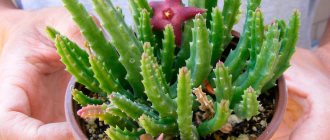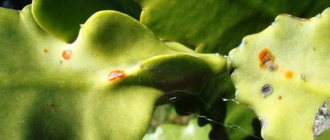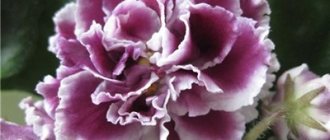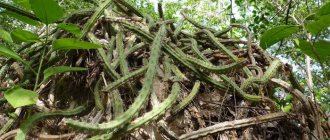Epiphyllum is a succulent perennial flower from the cactus family, genus Epiphytes. There are two dozen species in nature. Translated from Greek as “flower on leaves.” Places of distribution: South and Central America, subtropics of Africa, Mexico. It grows there on tree trunks and branches. Unlike plants, which receive energy from the tissues of the “host”, it feeds on its own. Used as an indoor flower, decoration of the garden, balcony, loggia.
Description and differences from the desert cactus
Cacti are one of the most ancient plants. Scientists believe that they existed 30–35 million years ago. There are 4 subfamilies and about 1800 species in the cactus family. Almost all of them have one common feature - they are stem succulents with reduced leaves that can accumulate moisture in the body, use it sparingly and survive in dry conditions.
Cacti have a variety of forms - among them there are trees, shrubs, vines, epiphytes, geophytes. Most members of the cactus family grow in deserts and semi-deserts. But there is a separate category, the main habitat of which is tropical rainforests. For the first time such plants were discovered in South America. They grew on trees.
Forest cacti usually do not have spines. They lead an epiphytic lifestyle. And most of them are shrubs, not exceeding 1 m in height, with aerial roots. The stems of forest cacti are green or brownish-green. They are covered with villi. The flowering of these plant crops is beautiful. The flowers are small and large, with simple and double petals, of various colors - from white to purple.
Some types of forest cacti are now successfully grown at home. Most often they are planted as hanging plants.
Diseases
Epiphyllum without good care will become an object for diseases. The plant is susceptible to fungal infection and viral mosaic.
Viral mosaic infection is very difficult to cure
When a flower is watered with cold water, over time it becomes covered with round spots - these are signs of a fungal infection. Darkening is clearly visible on the stems. You need to dig up the bush, dry the roots, removing damaged ones, and treat the entire crown and roots with a fungicidal preparation. In the future, try not to flood the flower.
If small white spots appear on the stems, it means that the plant has become infected with viral mosaic. It is extremely difficult to save a diseased epiphyllum; it is better to prevent the disease by protecting it from contact with diseased flowers.
Popular varieties
Forest cacti are grouped into 65 genera. There are many varieties that differ in appearance and flowering time. Despite significant differences in structure and appearance, these plants prefer the same microclimate. We invite you to get acquainted with five popular varieties of forest cacti that are suitable for home keeping.
Schlumberger
The name of this genus has several more synonyms: zygocactus, epiphyllum, epiphylanthus, Schlumbergera. Its representatives are common in the tropical zone of South America. The genus includes 9 species, 2 of which are actively used in home landscaping. These are Schlumbergera truncata, better known as the Christmas tree or Christmas cactus, and Schlumbergera bridgesii.
In nature, zygocactus grows on the trunks and roots of tropical crops. Since the 19th century it has been introduced into culture.
Zygocactus has several shoots 20–40 cm long, similar to a chain of elongated petals 2–5 cm in size, connected to each other. Flowers that look like lanterns form at the ends of the stems. Their petals can be colored red, yellow, lilac, white, pink. Aerial roots form on the elongated leaves of the plant.
Schlumbergera is most often used for hanging gardening, but it also looks beautiful in tall pots. Christmas tree prefers to grow in nutritious, well-drained, acidic soil in warm, moist conditions. In order for it to bloom, it must be kept at a temperature of +12...+25°C.
Pereskia
Pereskia or Peireskia is the only representative of the subfamily of the same name. The genus is named after the famous French botanist Nicolas-Claude Fabry de Peyresque. It is considered one of the most ancient in the cactus family. Its characteristic feature is the presence of true leaves. The genus includes 17 species. In nature, they are common in the southern regions of North America, most often in forested coastal areas. Some members of the genus have a stem. There are also species that grow as vines. Pereskia's areoles contain straight or curved spines with sharp ends. The cactus blooms with white, creamy yellow, and pink flowers. Depending on the species, they can grow singly or be combined into inflorescences. Pereskia fruits are edible. Residents of Brazil eat them as food, and also eat leaves and inflorescences.
When growing pereskia at home, you need a lot of light, warmth and fresh air. It needs nutritious soil, with a high content of sand and crushed stone. In winter, the plant should be kept cool. Flowering of domestic pereskia occurs rarely.
Rhipsalidopsis
Rhipsalidopsis or Hatiora grows in the tropical forests of Brazil. The genus, according to various sources, unites 5–10 species. Some of them are successfully grown indoors. The bushes of this cactus are compact. The shoots are branching, light green, consist of flat segments 4–6 cm long and 3 cm wide with spines at the ends. Flowers are formed at the ends of the segments. They are shaped like stars. Painted in various colors.
Representatives of the genus Ripsalidopsis are often confused with Christmas trees, but these are different plants and, if you look closely, you can see many differences, for example, in the structure of the shoot segments - Hatiora has smoothed protrusions at the edges, while Zygocactus has sharp teeth. The flowers are also different. In ripsalidopsis they have a smooth corolla, while in Christmas tree they have a slanted corolla. Finally, Rhipsalidopsis blooms in the spring, and Schlumbergera produces buds in December.
In order for representatives of the described genus to feel comfortable at home and produce abundant flowering, they must be kept at a temperature of +18...+20°C in summer, and at +10...12°C in winter. Plants grow well in high humidity, bright indirect light, and in light, slightly acidic soil.
Epiphyllum
Another interesting genus of epiphytic cacti, uniting 20 species. Its representatives attract attention with their unusual structure - the stems of the plants are similar to leaves, and flowers are formed at their ends. The stems are long, branching, droop down, and have aerial roots. There are varieties with flat and triangular stems. Epiphyllum blooms in spring and summer. Its flowers are large - they can reach 40 cm in length.
When planted in the house, epiphyllum looks beautiful as an hanging plant. For it, loose sandy soil and good lighting are selected. The temperature required is moderate, cool in winter.
Epiphyllum is also known as phyllocactus and phyllocereus.
Melocactus
Representatives of the genus Melocactus differ significantly from the cacti described above. Firstly, they have spines, and secondly, they are not epiphytes. There are 4 species found in the forests: Melocactus neryi, M. smithii, M. estevesii and M. mazelianus. They grow in the humid areas of Brazil, Guatemala, and Venezuela. Other members of the genus grow in arid regions. There is an opinion that melocacti were the first cacti that Europeans met when they arrived in South America. They began to be grown in England in the 15th century. Carl Linnaeus described melocacti in the 18th century. They are often called melon cacti.
The plants have a ribbed stem with oval, pubescent areoles. In nature, they can reach 1 m in height, but in indoor conditions they can be much lower. The trunk diameter is 10–20 cm. It is covered with hard spines. A cephalium forms at the top of the trunk. Flowers form in its areoles. They can be crimson, purple-pink, red, purple.
It is believed that melocactus, unlike its close relatives, is capricious when grown indoors. It needs bright lighting, shading from aggressive sunlight, a temperature of +10...+15°C in winter and +30°C in summer, and high humidity.
Epiphyllum
The name of this cactus is often confused with the general name of the family. But this plant has its own unique history. In the literature, this flower is often called a cactus orchid due to the height of the stem and the splendor of the flowers. All buds are collected in a funnel, which is framed by a large number of pink petals. The stem is cross-shaped, in the recesses of which there are dense leaves.
How to plant at home
Since in nature forest cacti grow in a climate different from that in which desert cacti grow, planting and care at home will also differ significantly. Only by following the recommendations on how to plant and care for these plants can you count on the fact that they will decorate your home for many years and even delight you with flowering.
The substrate requirements for forest cacti are as follows: it must be loose, well permeable to water and air. Most cacti prefer poor soils. Ready-made soil from the store, specially designed for cacti and succulents, will do. It is imperative to lay a high layer of drainage at the bottom of the pot.
If you prefer to plant plants in a substrate you made yourself, then the following options are suitable for forest cacti:
- Leaf and coniferous soil with an admixture of peat and sphagnum moss.
- A mixture of peat substrate with quartz sand, perlite, lavalite.
- A mixture of equal parts of turf soil, leaf soil, peat substrate, and brick chips.
- A substrate of three parts deciduous soil and two parts sand.
- A mixture of leaf, turf soil and sand in a ratio of 2:1:1.
Many cactus representatives prefer slightly acidic soils. Before growing any of the varieties, you should inquire about the preferences of the plant. Typically, forest cacti grow well in soil with an acidity of 5–6 pH.
Forest cacti can be grown in any pots that are suitable in size. They can be plastic or ceramic. The main thing is not to plant them in containers that are too large, otherwise you will have to wait too long for flowering.
Selecting dishes and soil for planting
For proper growing season and beautiful flowering, the pot in which the cactus is grown is of great importance. When choosing a container, take into account the size of the plant and its tendency to grow upward. Adult flowers are transplanted at the age of 3-4 years only after the roots grow from below in the pot through the drainage holes. For young specimens, the soil is changed annually.
On this topic:
BACK
FORWARD
1 of 4
Pot size
The cactus does not have a very large rhizome, so it prefers shallow containers. In order for epiphyllium to bloom actively, the pot must be too small for its rhizome. This stimulates the flower to form buds. When replanting overgrown specimens, take flowerpots that are 2-4 cm larger than the previous ones.
Utensil shape
Many gardeners try to grow cacti in rectangular containers so that as many pots as possible can fit on the windowsill. But this approach is wrong, since the close arrangement of plants prevents free air circulation. This can lead to root rot due to moisture disturbance. Therefore, for epiphyllum it is better to take a round pot.
Care
When caring for forest cacti, you should adhere to several important rules:
- Maintain high humidity levels by spraying.
- Reduce moisturizing in winter to a minimum - 2 times a month. Stop spraying altogether.
- Do not spray cacti during flowering.
- Keep crops in bright, indirect light.
- Transplant annually into a container with a larger diameter by 1–2 cm.
The best place to keep forest cacti is an eastern windowsill. When growing on a north window, additional lighting will be required; on a south window, shading from direct rays of the sun will be required.
In summer, cacti feel good at +20...+30°C. In winter they need coolness. At this time, forest cacti are kept at +15...+18°C. Temperature drops to +10°C and below are dangerous for plants. At the same time as the temperature drops, the amount of watering is also reduced. In cold weather, it is important not to overwater cacti, otherwise they may rot.
In summer, plants need to be watered 2 times a week. The water should be at room temperature, always standing for 1–2 days. Water the plants at the roots.
All cacti, except epiphyllum, must be replanted once a year after flowering. Epiphyllum will bloom only if it grows in a cramped pot.
Cacti do not need frequent feeding. Fertilizers can be applied no more than once a month.
Zygocactus
This plant is also known as Schlumberger. This cactus is considered the most common; it is loved for its unpretentiousness and ease of care. The plant is very beautiful, delicate during flowering. The zygocactus leaf consists of many segments with sharp tips. Schlumberger blooms in raspberry, white, pink, and lilac colors.
Reproduction
Forest cacti can be propagated by seed or cuttings. For some varieties, propagation by layering is suitable.
The seeds are planted in a mixture of peat and sand. Their germination temperature is from +20 to +25°C. Sowing can be done as usual: scatter the seeds over the surface of the substrate, sprinkle with a low layer of soil, moisten, cover with film until sprouts appear. Ventilate daily and moisten as the soil dries out.
Cuttings are prepared from young or old shoots. After separation, they must be dried. It is advisable to treat with a root former. For rooting, it should be planted in a mixture of peat and sand. Roots should form within 2–6 weeks. After the root system becomes strong, transplant into another container.
So, forest cacti are very interesting and original plants that are worth decorating your home windowsills with. Their agricultural technology is simple, the main thing is to create the right microclimate and regularly care for the crops. Then they will not only delight you with a healthy appearance, but will also give you bright, abundant flowering.
Rest period
The cessation of growth and flowering in most epiphyllums occurs in winter. It is during this period that there is no need to wash the flower and fertilize it. They also reduce spraying and watering, and monitor the temperature - too hot a temperature is not very favorable for the cactus.
One interesting fact that not all epiphyllum owners know about is the gift of fruit. After flowering, a kind of peduncle is attached to the stem - this is the fruit that can be eaten! Since it is prickly, it is first cleared of thorns. Most people who have tasted the epiphyllum fruit associate the mixture of persimmon and banana flavors.
Reviews from flower growers
I love this flower for its bright pink-raspberry star buds. Each time the flowering occurs on New Year's Eve, and also in the middle of summer, it seems. The plant loves water very much and does not tolerate bright light and heat at all. Only there are problems with the shoots - they don’t take root.
AquaMarinka
https://smoldacha.ru/forum/komnatnoe_cvetovodstvo/topic_27
It’s not for nothing that I called Decembrist the flower of winter. It begins to form buds at the end of November, and in December, when it is already winter outside, the Decembrist begins to bloom on your windowsill. How beautiful it is. I have a pink and white Decembrist growing. This is an unpretentious and grateful flower. Don’t forget to water it and don’t move or touch it during flowering, it doesn’t like it, it starts to drop its buds, and then your Decembrist will delight you with its beauty from December to March. Now March is approaching, and my Decembrists have begun to put on buds again. I think it will still bloom throughout March. By the way, he is not afraid of the heat either. I’m on the sunny side, but he withstands this heat as if nothing had happened. And he doesn’t get capricious when I open the window for a long time in winter. Nothing matters to him. A real Decembrist!
Elena
https://www.imho24.ru/recommendation/44738/
Remember this wonderful song? Do you want to see how flowers bloom in November, when the first frosts have gripped the ground and the white shine of the morning frost outside the window leaves no chance for greenery? The Decembrist flower on the window is just what you need in this grey-white hazy time!
Lens
https://irecommend.ru/content/dekabrist?new=1
Decembrist can have pink and carmine-red and purple flowers. And it usually blooms after stress, if it was cool, if it was not watered for a long time and it was dry, and there are also varieties according to flowering periods: winter and summer. It bloomed beautifully. You can’t touch it, move it or turn it during flowering; it will immediately drop its buds.
Okluba
https://www.forumhouse.ru/threads/53931/page-4











